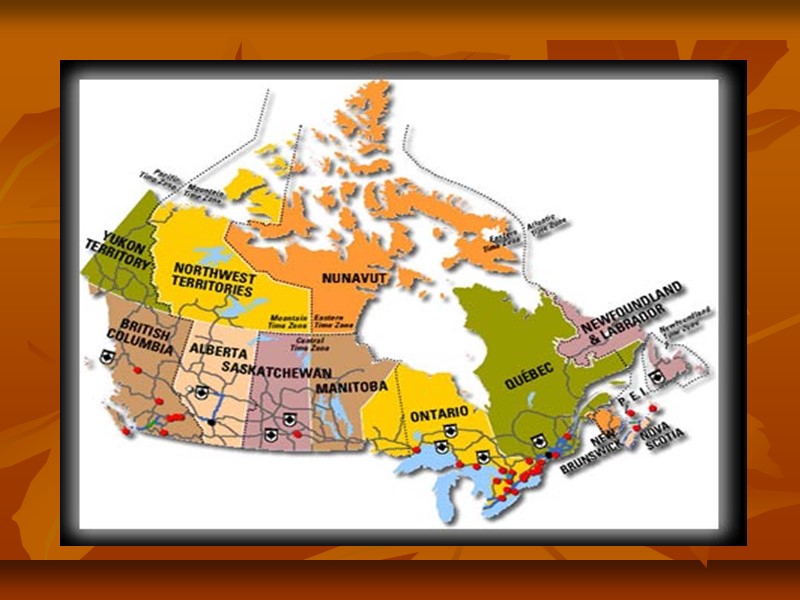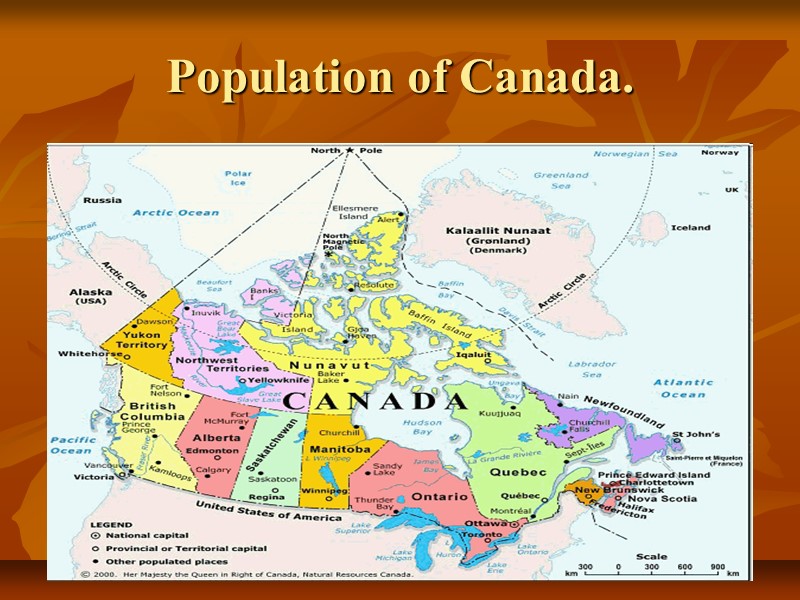 Population of Canada.
Population of Canada.
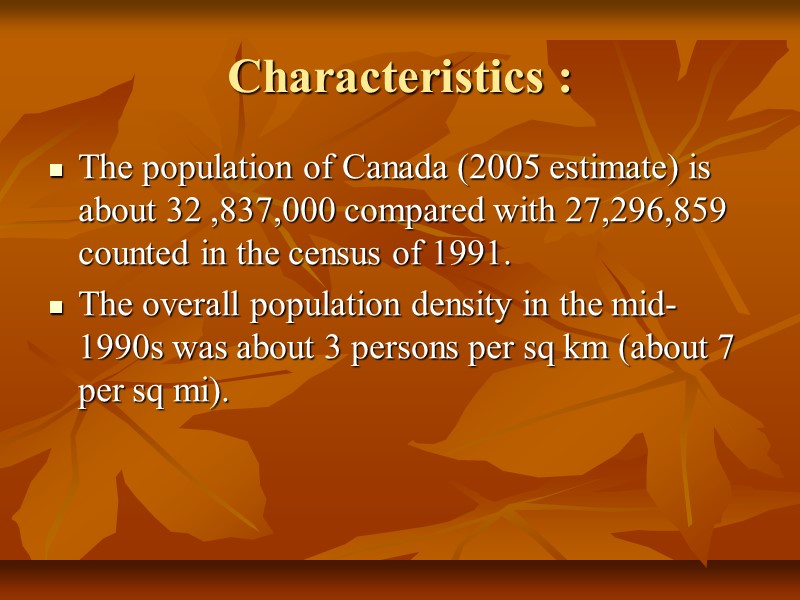 Characteristics : The population of Canada (2005 estimate) is about 32 ,837,000 compared with 27,296,859 counted in the census of 1991. The overall population density in the mid-1990s was about 3 persons per sq km (about 7 per sq mi).
Characteristics : The population of Canada (2005 estimate) is about 32 ,837,000 compared with 27,296,859 counted in the census of 1991. The overall population density in the mid-1990s was about 3 persons per sq km (about 7 per sq mi).
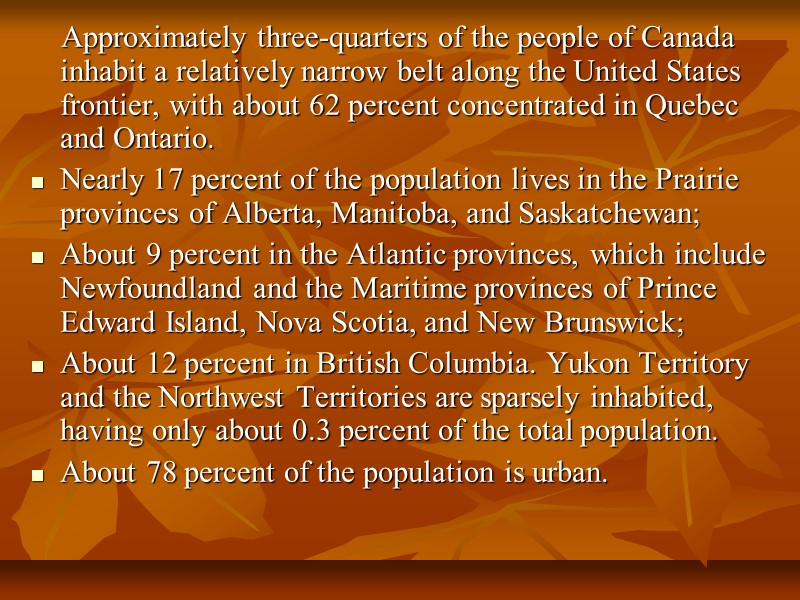 Approximately three-quarters of the people of Canada inhabit a relatively narrow belt along the United States frontier, with about 62 percent concentrated in Quebec and Ontario. Nearly 17 percent of the population lives in the Prairie provinces of Alberta, Manitoba, and Saskatchewan; About 9 percent in the Atlantic provinces, which include Newfoundland and the Maritime provinces of Prince Edward Island, Nova Scotia, and New Brunswick; About 12 percent in British Columbia. Yukon Territory and the Northwest Territories are sparsely inhabited, having only about 0.3 percent of the total population. About 78 percent of the population is urban.
Approximately three-quarters of the people of Canada inhabit a relatively narrow belt along the United States frontier, with about 62 percent concentrated in Quebec and Ontario. Nearly 17 percent of the population lives in the Prairie provinces of Alberta, Manitoba, and Saskatchewan; About 9 percent in the Atlantic provinces, which include Newfoundland and the Maritime provinces of Prince Edward Island, Nova Scotia, and New Brunswick; About 12 percent in British Columbia. Yukon Territory and the Northwest Territories are sparsely inhabited, having only about 0.3 percent of the total population. About 78 percent of the population is urban.
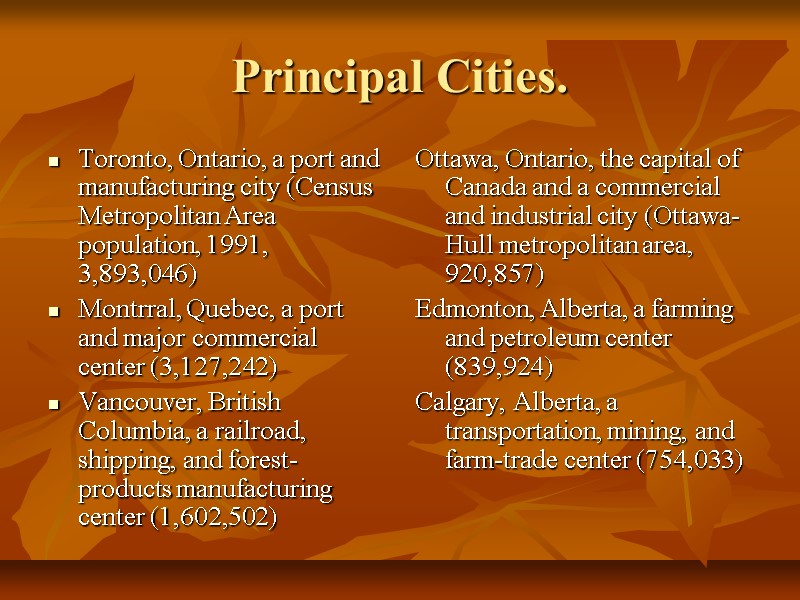 Principal Cities. Toronto, Ontario, a port and manufacturing city (Census Metropolitan Area population, 1991, 3,893,046) Montrral, Quebec, a port and major commercial center (3,127,242) Vancouver, British Columbia, a railroad, shipping, and forest-products manufacturing center (1,602,502) Ottawa, Ontario, the capital of Canada and a commercial and industrial city (Ottawa-Hull metropolitan area, 920,857) Edmonton, Alberta, a farming and petroleum center (839,924) Calgary, Alberta, a transportation, mining, and farm-trade center (754,033)
Principal Cities. Toronto, Ontario, a port and manufacturing city (Census Metropolitan Area population, 1991, 3,893,046) Montrral, Quebec, a port and major commercial center (3,127,242) Vancouver, British Columbia, a railroad, shipping, and forest-products manufacturing center (1,602,502) Ottawa, Ontario, the capital of Canada and a commercial and industrial city (Ottawa-Hull metropolitan area, 920,857) Edmonton, Alberta, a farming and petroleum center (839,924) Calgary, Alberta, a transportation, mining, and farm-trade center (754,033)
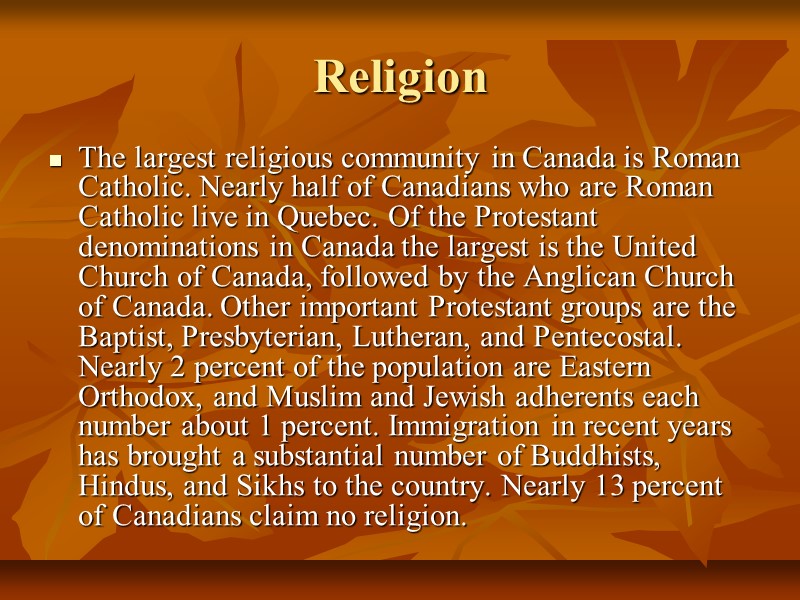 Religion The largest religious community in Canada is Roman Catholic. Nearly half of Canadians who are Roman Catholic live in Quebec. Of the Protestant denominations in Canada the largest is the United Church of Canada, followed by the Anglican Church of Canada. Other important Protestant groups are the Baptist, Presbyterian, Lutheran, and Pentecostal. Nearly 2 percent of the population are Eastern Orthodox, and Muslim and Jewish adherents each number about 1 percent. Immigration in recent years has brought a substantial number of Buddhists, Hindus, and Sikhs to the country. Nearly 13 percent of Canadians claim no religion.
Religion The largest religious community in Canada is Roman Catholic. Nearly half of Canadians who are Roman Catholic live in Quebec. Of the Protestant denominations in Canada the largest is the United Church of Canada, followed by the Anglican Church of Canada. Other important Protestant groups are the Baptist, Presbyterian, Lutheran, and Pentecostal. Nearly 2 percent of the population are Eastern Orthodox, and Muslim and Jewish adherents each number about 1 percent. Immigration in recent years has brought a substantial number of Buddhists, Hindus, and Sikhs to the country. Nearly 13 percent of Canadians claim no religion.
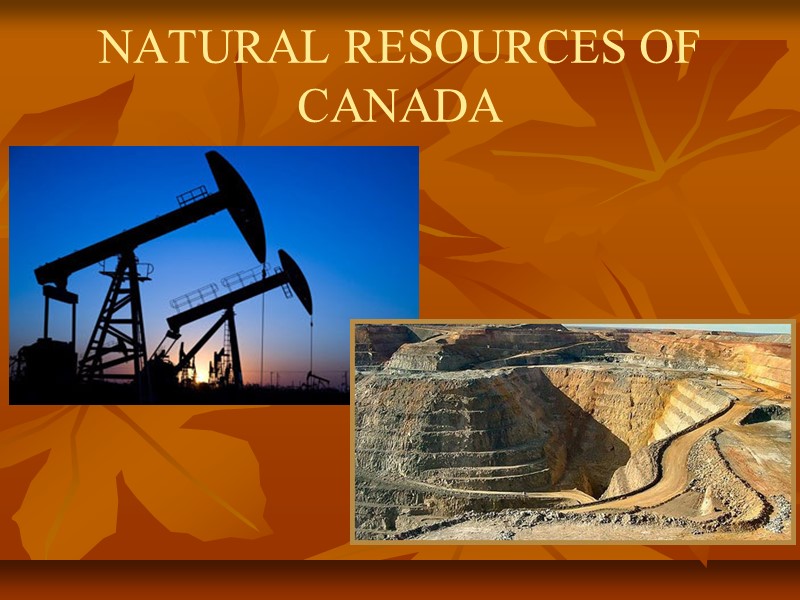 NATURAL RESOURCES OF CANADA
NATURAL RESOURCES OF CANADA
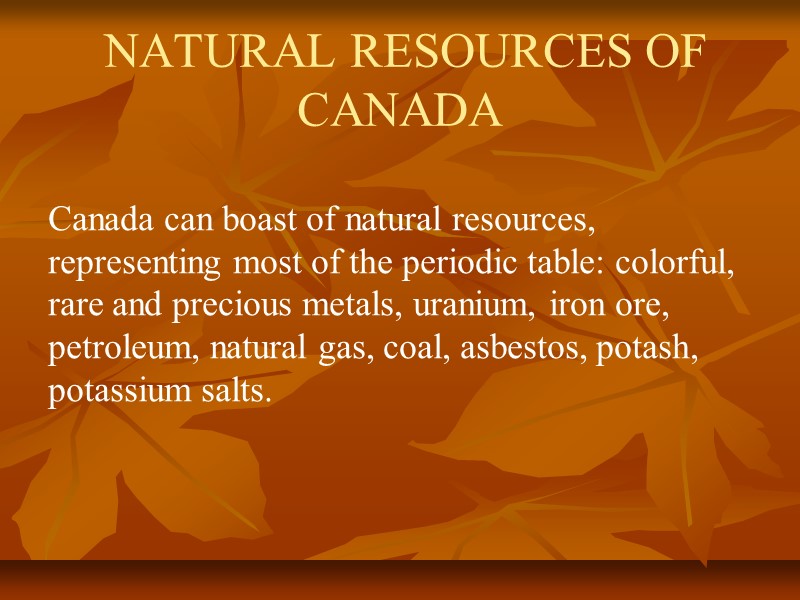 NATURAL RESOURCES OF CANADA Canada can boast of natural resources, representing most of the periodic table: colorful, rare and precious metals, uranium, iron ore, petroleum, natural gas, coal, asbestos, potash, potassium salts.
NATURAL RESOURCES OF CANADA Canada can boast of natural resources, representing most of the periodic table: colorful, rare and precious metals, uranium, iron ore, petroleum, natural gas, coal, asbestos, potash, potassium salts.
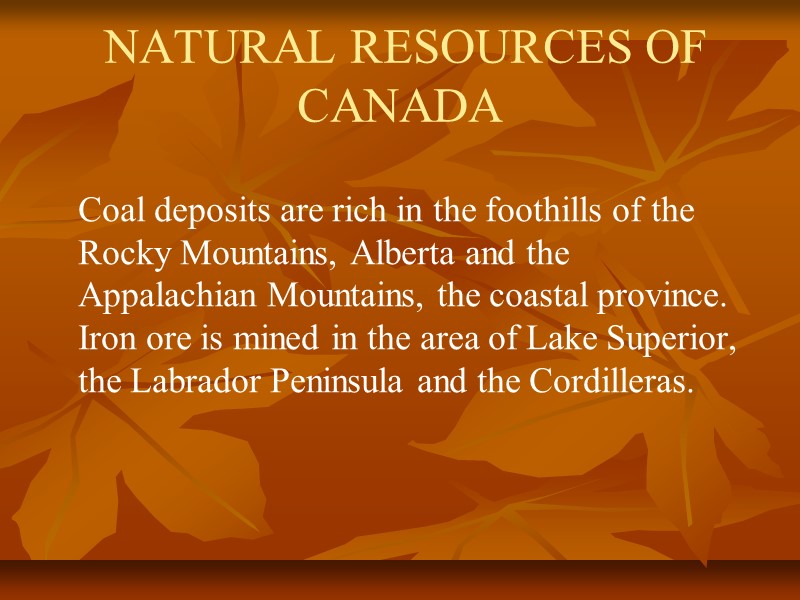 NATURAL RESOURCES OF CANADA Coal deposits are rich in the foothills of the Rocky Mountains, Alberta and the Appalachian Mountains, the coastal province. Iron ore is mined in the area of Lake Superior, the Labrador Peninsula and the Cordilleras.
NATURAL RESOURCES OF CANADA Coal deposits are rich in the foothills of the Rocky Mountains, Alberta and the Appalachian Mountains, the coastal province. Iron ore is mined in the area of Lake Superior, the Labrador Peninsula and the Cordilleras.
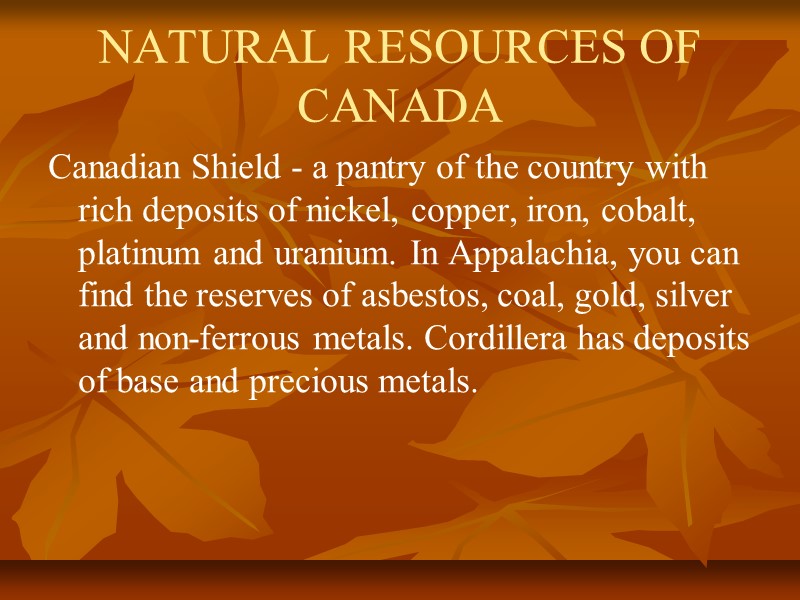 NATURAL RESOURCES OF CANADA Canadian Shield - a pantry of the country with rich deposits of nickel, copper, iron, cobalt, platinum and uranium. In Appalachia, you can find the reserves of asbestos, coal, gold, silver and non-ferrous metals. Cordillera has deposits of base and precious metals.
NATURAL RESOURCES OF CANADA Canadian Shield - a pantry of the country with rich deposits of nickel, copper, iron, cobalt, platinum and uranium. In Appalachia, you can find the reserves of asbestos, coal, gold, silver and non-ferrous metals. Cordillera has deposits of base and precious metals.
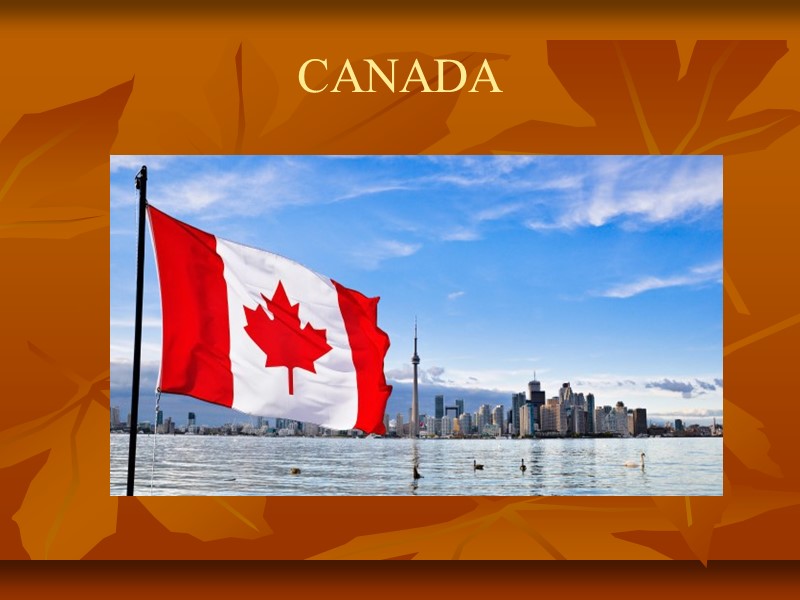 CANADA
CANADA



